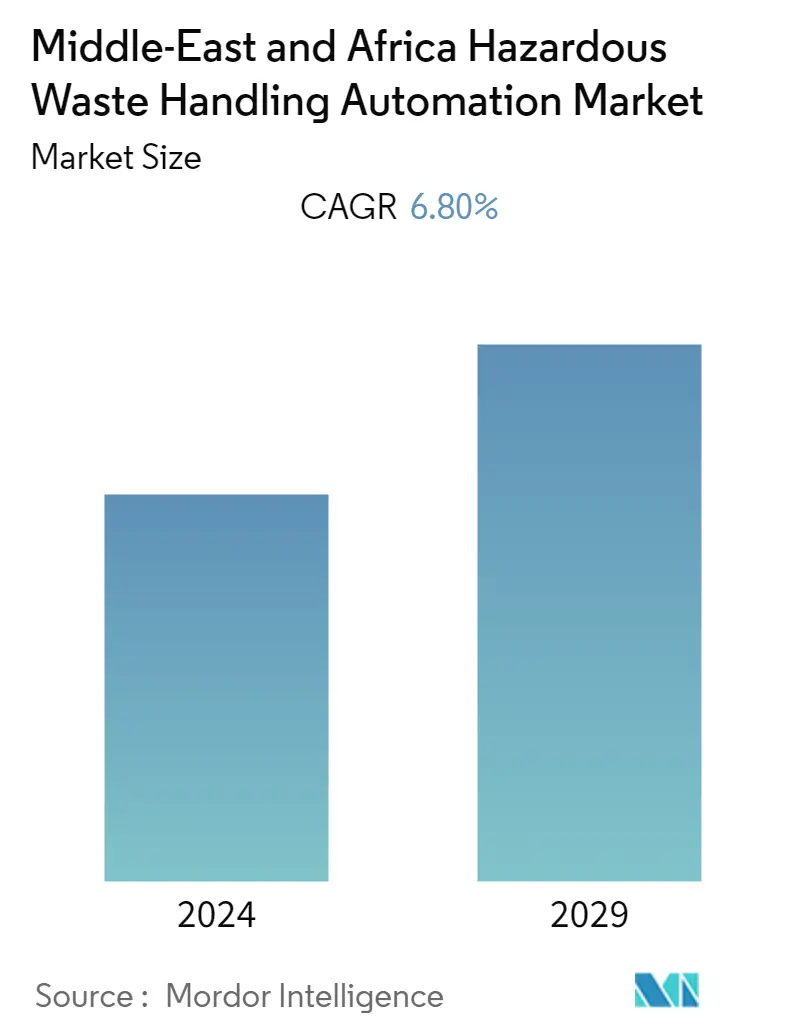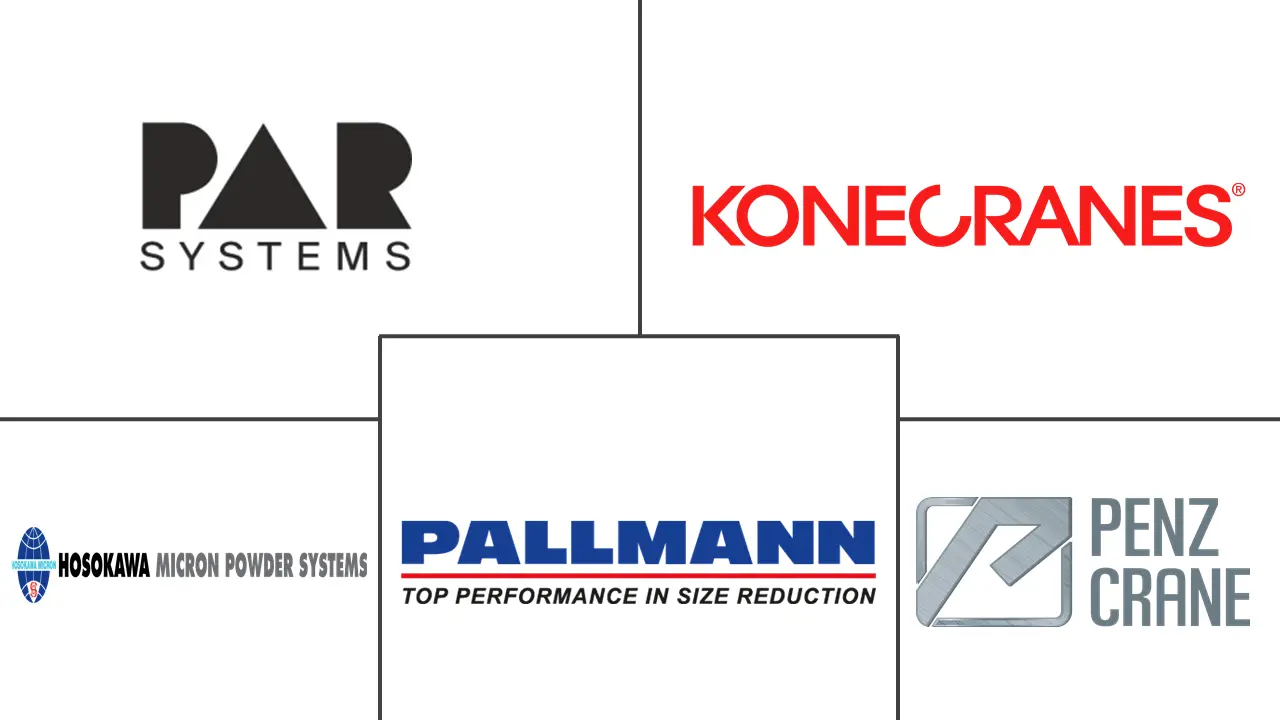Market Size of Middle-East and Africa Hazardous Waste Handling Automation Industry

| Study Period | 2019 - 2029 |
| Base Year For Estimation | 2023 |
| Forecast Data Period | 2024 - 2029 |
| Historical Data Period | 2019 - 2022 |
| CAGR | 6.80 % |
| Market Concentration | Medium |
Major Players
*Disclaimer: Major Players sorted in no particular order |
Middle-East and Africa Hazardous Waste Handling Automation Market Analysis
The Middle-East and Africa hazardous waste handling automation market is expected to register a CAGR of 6.8% during the forecast period (2022-2027). Hazardous waste materials and their management are highly important for the safety of workers and society. Several government regulations and growing awareness among people about sustainability are some of the key factors driving the market growth.
Hazardous waste poses an actual or potential hazard to humans' health and other living organisms or the environment, owing to its toxic, flammable, infectious, and radioactive properties.
The management of hazardous waste is one of the emerging issues in the Middle-East and African region as companies from the developed regions have been dumping their toxic waste in Africa for many years, as regulating measures for hazardous waste management in the region are still not on a par with international legislation. However, the governments in the region are now taking initiatives and are banning this practice as a result of their awareness of growing health concerns.
In the Middle East, a large percentage of hazardous waste is produced from petroleum products and from frequent wars, including shellings, casings, and other types of war remain.
Some of these wastes can be handled manually, while some may require expertise and automation solutions to minimize human contact with the waste. The use of such automation solutions for handling waste also improves process efficiency and reduces the reliance on manual intervention. Thus, concerns about the proper handling of these harmful substances can be eliminated.
Different products used in hazardous waste handling automation include cranes, manipulator arms, and size reduction arms.
As the outbreak of COVID-19 impacted the Middle-East and African region, many types of additional medical and hazardous wastes were generated, including infected masks, gloves, and other protective equipment. This has further augmented the demand for effective hazardous waste handling practices in the region.
Moreover, initiatives such as Power Africa, taken by the United States Agency for International Development (U.S.A.I.D.) and various partners, aim to have 25 million to 30 million new solar connections across Africa by 2030. Such initiatives are expected to generate a significant amount of waste, including expired lead-acid batteries and power backup systems. This is expected to drive the demand for automated hazardous waste handling solutions for efficient and safe handling.
Middle-East and Africa Hazardous Waste Handling Automation Industry Segmentation
Hazardous waste management is the collection, disposal, and treatment of harmful materials. If improperly handled, it can cause substantial harm to human health and the environment. These include waste materials generated on a day-to-day basis by people, power plants, and manufacturing companies. The report contains a wide range of information about the leading market players and the major strategies adopted by them based on the analysis of the market segmented by type of waste, automation products, and industry.
| Automation Product | |
| Manipulator Arms | |
| Telescoping Masts | |
| Cranes | |
| Trusses | |
| Size Reduction Systems | |
| Other Automation Products |
| Type of Waste | |
| Listed Wastes | |
| Charecteristic Wastes | |
| Universal Waste | |
| Mixed Waste |
| Industry | |
| Manufacturing | |
| Chemical | |
| Energy | |
| Consumer Care | |
| Government | |
| Other Industries |
| Geography | |
| Saudi Arabia | |
| United Arab Emirates | |
| Israel | |
| South Africa | |
| Rest of Middle-East and Africa |
Middle-East and Africa Hazardous Waste Handling Automation Market Size Summary
The Middle-East and Africa hazardous waste handling automation market is experiencing significant growth, driven by increasing awareness of sustainability and stringent government regulations. The region faces unique challenges, such as the historical dumping of toxic waste by developed countries and the high generation of hazardous waste from industries like oil and gas, as well as from conflicts. Automation solutions are becoming essential to improve efficiency and minimize human contact with hazardous materials. The COVID-19 pandemic has further intensified the demand for effective waste handling practices due to the surge in medical waste. Initiatives like Power Africa are expected to generate substantial waste, including lead-acid batteries, thereby boosting the need for automated solutions.
E-waste management is a critical issue in the region, with countries like Nigeria and Ghana struggling with the influx of used electronics. The presence of hazardous substances in e-waste poses environmental and health risks, prompting governments to collaborate with external agencies for safe disposal. Saudi Arabia, a major generator of e-waste, is implementing new regulations to manage waste effectively. The market is becoming increasingly competitive, with key players like PAR Systems and Konecranes leading the charge. Strategic partnerships and technological advancements are enhancing waste management capabilities, supporting the region's efforts to address hazardous waste challenges.
Middle-East and Africa Hazardous Waste Handling Automation Market Size - Table of Contents
-
1. MARKET INSIGHTS
-
1.1 Market Overview
-
1.2 Industry Attractiveness - Porter's Five Forces Analysis
-
1.2.1 Threat of New Entrants
-
1.2.2 Bargaining Power of Buyers
-
1.2.3 Bargaining Power of Suppliers
-
1.2.4 Threat of Substitute Products
-
1.2.5 Intensity of Competitive Rivalry
-
-
1.3 Assessment of the Impact of COVID-19 on the Market
-
-
2. MARKET SEGMENTATION
-
2.1 Automation Product
-
2.1.1 Manipulator Arms
-
2.1.2 Telescoping Masts
-
2.1.3 Cranes
-
2.1.4 Trusses
-
2.1.5 Size Reduction Systems
-
2.1.6 Other Automation Products
-
-
2.2 Type of Waste
-
2.2.1 Listed Wastes
-
2.2.2 Charecteristic Wastes
-
2.2.3 Universal Waste
-
2.2.4 Mixed Waste
-
-
2.3 Industry
-
2.3.1 Manufacturing
-
2.3.2 Chemical
-
2.3.3 Energy
-
2.3.4 Consumer Care
-
2.3.5 Government
-
2.3.6 Other Industries
-
-
2.4 Geography
-
2.4.1 Saudi Arabia
-
2.4.2 United Arab Emirates
-
2.4.3 Israel
-
2.4.4 South Africa
-
2.4.5 Rest of Middle-East and Africa
-
-
Middle-East and Africa Hazardous Waste Handling Automation Market Size FAQs
What is the current Middle-East and Africa Hazardous Waste Handling Automation Market size?
The Middle-East and Africa Hazardous Waste Handling Automation Market is projected to register a CAGR of 6.80% during the forecast period (2024-2029)
Who are the key players in Middle-East and Africa Hazardous Waste Handling Automation Market?
PAR Systems, Konecranes, Pallmann Maschinenfabrik GmbH & Co. KGPallman Gmbh, Hosokawa Micron Powder Systems and PENZ Crane Gmbh are the major companies operating in the Middle-East and Africa Hazardous Waste Handling Automation Market.

